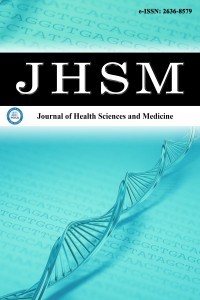Evaluation of non-traumatic intracranial hemorrhages as cause of cardiac arrest in emergency department
Aim: Cardiac arrests can be brought to emergency departments with an intervention from out-of hospital, and they can also occur for different reasons in the emergency department. Due to the high rates of mortality in this important clinical situation, regulations are made through guidelines and algorithms. Most of these regulations cover acute coronary syndromes and special conditions. The aim of our study is to evaluate intracranial hemorrhages in non-traumatic cardiac arrest cases in our emergency department for a period of 10 years.
Material and method: The data of patients 18 years of age and over who were found to have cardiac arrest in the emergency department between January 2011 and January 2021, who did not have trauma, were retrospectively scanned from the hospital information management system. Demographic information of all patients, computed tomography examinations for intracranial hemorrhage and emergency department outcomes were evaluated.
Results: Of the 173 patients included in the study, 81 (46.8%) were women. The median age of the patients was determined as 72.00 (64.00-80.00). In the whole patient group, 20 (11.6%) patients had intracranial bleeding and 10 of these patients were women. More intrcranial hemorrhage was detected in the group that underwent CT before cardiopulmonary resuscitation (CPR) and it was statistically significant (p
Keywords:
Cardiac arrest, Intracranial Hemorrhage, Emergency department,
___
- Soar J, Böttiger BW, Carli P, et al. European resuscitation council guidelines 2021: adult advanced life support. Resuscitation 2021; 161: 115–51.
- Part 3: Adult Basic and Advanced Life Support: 2020 American Heart Association Guidelines for Cardiopulmonary Resuscitation and Emergency Cardiovascular Care | Circulation [Internet]. [cited 2021 Apr 22]. Available from: https://www.ahajournals.org/doi/10.1161/CIR.0000000000000916
- Skrifvars MB, Parr MJ. Incidence, predisposing factors, management and survival following cardiac arrest due to subarachnoid haemorrhage: a review of the literature. Scand J Trauma Resusc Emerg Med 2012; 20: 75.
- Wallmuller C, Meron G, Kurkciyan I, Schober A, Stratil P, Sterz F. Causes of in-hospital cardiac arrest and influence on outcome. Resuscitation 2012; 83: 1206–11.
- Cocchi MN, Lucas JM, Salciccioli J, et al. The role of cranial computed tomography in the immediate post-cardiac arrest period. Intern Emerg Med 2010; 5: 533–8.
- Andersen LW, Holmberg MJ, Berg KM, Donnino MW, Granfeldt A. In-Hospital cardiac arrest. JAMA 2019; 321: 1200–10.
- Schluep M, Gravesteijn BY, Stolker RJ, Endeman H, Hoeks SE. One-year survival after in-hospital cardiac arrest: a systematic review and meta-analysis. Resuscitation 2018; 132: 90–100.
- Akinboro O, Olorunfemi O, Jesmajian S, Ovbiagele B. Epidemiology and outcomes of in-hospital cardiac arrest after stroke in the United States. Neurology 2016; 86: P1.222
- Naples R, Ellison E, Brady WJ. Cranial computed tomography in the resuscitated patient with cardiac arrest. Am J Emerg Med 2009; 27: 63–7.
- Algorithms for Advanced Cardiac Life Support 2021 [Internet]. [cited 2021 Mar 22]. Available from: https://www.acls.net/aclsalg.htm
- Nolan JP, Berg RA, Andersen LW, et al. Cardiac Arrest and Cardiopulmonary Resuscitation Outcome Reports: Update of the Utstein Resuscitation Registry Template for In-Hospital Cardiac Arrest: A Consensus Report From a Task Force of the International Liaison Committee on Resuscitation. Circulation 2019; 140: 746-57.
- Kürkciyan I, Meron G, Sterz F, et al. Spontaneous subarachnoid haemorrhage as a cause of out-of-hospital cardiac arrest. Resuscitation 2001; 51: 27–32.
- Shin J, Kim K, Lim YS, et al. Incidence and clinical features of intracranial hemorrhage causing out-of-hospital cardiac arrest: a multicenter retrospective study. Am J Emerg Med 2016; 34: 2326–30.
- Inamasu J, Miyatake S, Tomioka H, et al. Headache, cardiac arrest, and intracranial hemorrhage. J Headache Pain 2009; 10: 357–60.
- Lattanzi S, Silvestrini M. Blood pressure in acute intra-cerebral hemorrhage. Ann Transl Med 2016; 4: 320.
- Gelber J, Montgomery ME, Singh A. A prospective study of the incidence of intracranial hemorrhage in survivors of out of hospital cardiac arrest. Am J Emerg Med 2021; 41: 70–2.
- Yayın Aralığı: Yılda 6 Sayı
- Başlangıç: 2018
- Yayıncı: MediHealth Academy Yayıncılık
Sayıdaki Diğer Makaleler
Hasan ÖZTİN, İlyas OZTURK, Burak OYMAK
Mustafa Emin ÇANAKÇI, Kübra PARPUCU BAĞÇECİ, Engin ÖZAKIN, Nurdan ACAR
Merve Sefa SAYAR, Dilek BULUT, Sebahattin ÇELİK, Veysel BURULDAY, Remzi SARIKAYA, Nurettin KURT
Hasan Basri ÇETİNKAYA, Tufan ALATLI
Flaxseed: a promising alternative for polycystic ovarian syndrome therapy
Ozgur OZTAN, Vugar Ali TÜRKSOY, Serdar DENİZ, Servet Birgin İRİTAŞ, Engin TUTKUN
